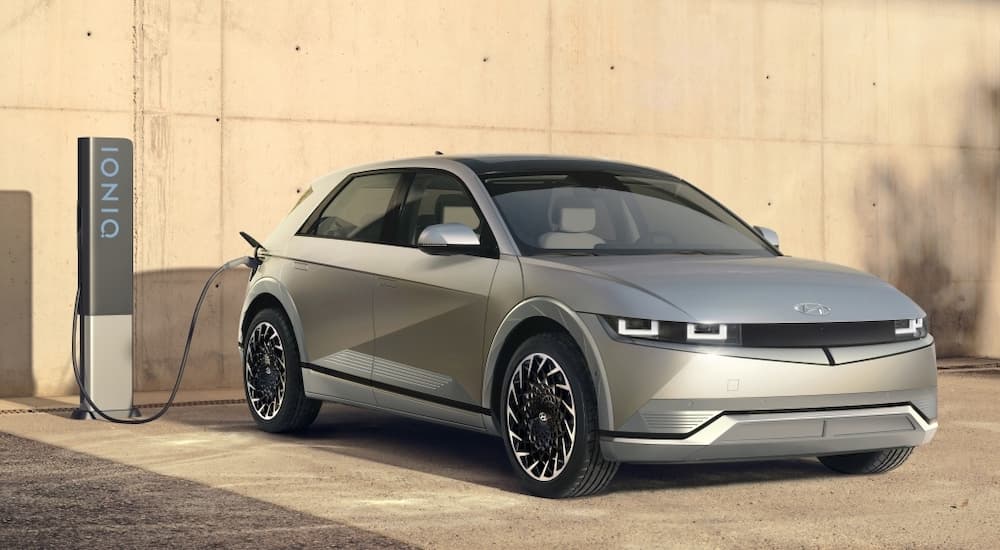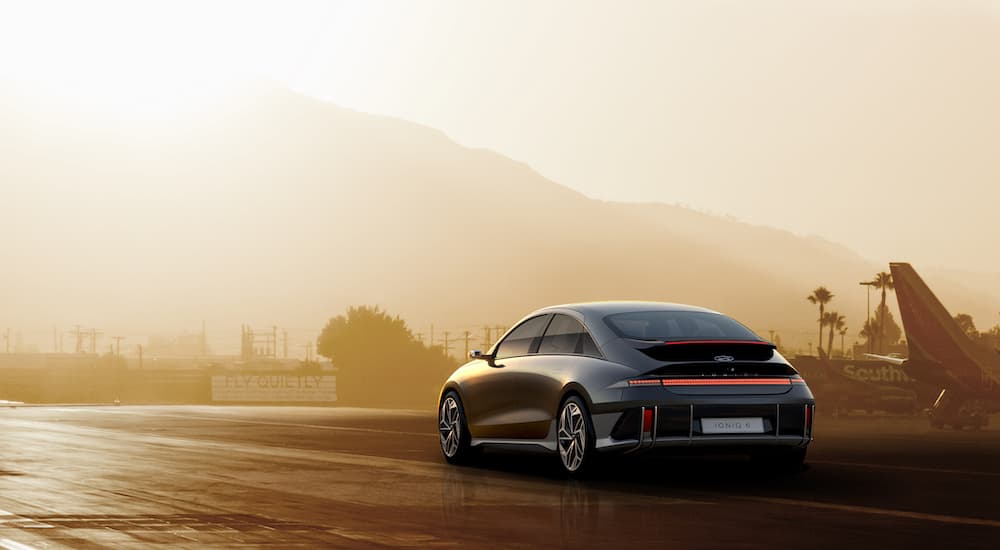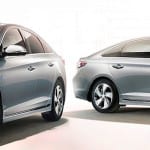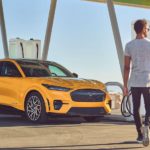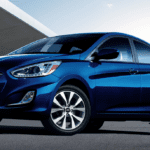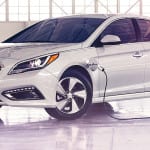Many auto industry observers consider the future electric, and most automakers have taken note, building at least one or two hybrid or battery electric vehicles (BEV) as part of their regular lineups. However, few automakers have embraced the electric future quite like Hyundai. If you stop into a Canadian Hyundai dealership, you will probably be struck by the number and type of different hybrid and BEV models for sale. This is because Hyundai has made a huge bet on these alternative energy vehicles, seemingly offering most of its popular models with at least one hybrid engine option while at the same time expanding its BEV offerings.
In some ways, this has paid off immediately, with Hyundai winning a number of World Car Awards for its BEVs. As a result, Hyundai has decided to go all-in with respect to electromobility, with the lofty goal of capturing up to 12 percent of the world market share of EVs within the next decade. This explains why Hyundai has come out with so many different hybrid and BEV models, especially for the 2022 model year. It also is the reasoning behind the decision to invest $7.16 billion CAD into an electric vehicle and battery manufacturing plant in North America.
What Is the Difference Between a Hybrid and BEV?
One of the biggest questions many drivers have is the difference between a hybrid and a BEV. The key difference is that a BEV operates using only electrical power, while the hybrid blends a gas engine with a battery-powered electric motor. So, while the hybrid reduces your vehicle’s gasoline consumption, the BEV is designed to permanently free you from the pump. As a result, while a hybrid’s value is judged by its fuel economy numbers, you can determine the quality of a BEV by the estimated range.
There are a few similarities. First, both types of vehicles contain an electric motor powered by a powerful battery. In the case of Hyundai, the company utilizes a lithium battery pack. However, hybrids are able to use a portion of the output from the gas engine to recharge the vehicle’s battery.
Second, hybrids and BEVs use energy recapture to recharge the battery. This is usually done by capturing the energy released when you apply the brakes. This is called regenerative braking and is the reason why electrified vehicles often have better fuel economy numbers in city driving than on the highway. This is actually the opposite of conventional gas engines, which give you better fuel economy numbers when you are on the highway.
Finally, some hybrids have a plug-in feature, like on a BEV, making the recharging of the vehicle’s battery more convenient. You can either plug into a wall charger at home or the office or recharge your Hyundai plug-in hybrid or BEV on the road by going to one of many public chargers located on major roadways.
Hyundai’s Approach to Hybrids
Like many other automakers, Hyundai entered the EV sweepstakes in 2017 with a purpose-built platform, the Ioniq. However, unlike other automakers like Toyota with the Prius, Hyundai designed the Ioniq to provide drivers with a choice of three different models, two of which are hybrids. The third is a BEV.
The 2022 Hyundai Ioniq showcases the two different ways that Hyundai approaches hybrid vehicles. The first is a standard hybrid. This comes with a 1.6L I-4 gas engine paired with a 6-speed dual-clutch transmission, making it capable of 139 hp and 195 lb-ft of torque when combined with the vehicle’s electric motor. This is actually the same powertrain as on the 2022 Elantra Hybrid. However, the front-wheel drive Ioniq Hybrid provides better overall fuel economy at 4.0 L/100 km combined. In contrast, the front-wheel drive Elantra Hybrid will give you a still-solid 4.4 L/100 km combined.
Hyundai also offers the 2022 Ioniq as a plug-in hybrid. This features the same 1.6L I-4 as the hybrid model but with the addition of a larger 8.9 kWh battery. As a result, the 2022 Ioniq Plug-in Hybrid can produce 164 hp and 195 lb-ft of torque combined. It will give you an estimated 2.0 Le/100 km, with a range of 47 km on battery power alone.
As shown by the 2022 Elantra Hybrid, Hyundai has rolled out the hybrid option for a number of its other models that began life as conventional gasoline vehicles. This includes the Santa Fe Hybrid and Plug-in Hybrid, the Sonata Hybrid, and the Tucson Hybrid and Plug-in Hybrid. This gives Canadians an alternative energy option for some of Hyundai’s most popular vehicle designs.
For example, a 2022 Santa Fe Plug-in Hybrid combines a 1.6L I-4 gas engine with a 13.8 kWh battery pack on a roomy midsize SUV. Similarly, a 2022 Sonata Hybrid gives you a comfortable midsize sedan with a 2.0L I-4 hybrid gas engine that can give you a very impressive 5.0 L/100 km combined. Finally, the 2022 Tucson Hybrid and Plug-in Hybrid take the 1.6L I-4 from many of Hyundai’s hybrid models and add a turbocharger to boost performance, giving you exceptional speed and acceleration on this hybrid compact SUV.
Building a BEV
When Hyundai moved into the electric vehicle market, it utilized the Ioniq platform. This is why the Ioniq Electric debuted in the 2017 model year alongside its two hybrid siblings. However, Hyundai discontinued the Ioniq Electric following the 2021 model year, replacing it with an all-new Ioniq 5, an electric-only compact SUV. This model offers drivers a choice of three different electric motor options, each with a different range.
The base model 2022 Ioniq 5 features a 58 kWh battery powering the vehicle’s rear axle. This will give you 168 hp and 258 lb-ft of torque, making it capable of going 354 km on a single full charge. The next step up is also rear-wheel drive but features an extended range 77.4 kWh battery. This delivers 225 hp and 258 lb-ft of torque, with an estimated range of 488 km. This model has the greatest estimated range of the three 2022 Ioniq 5 BEVs on offer. The third model also has an extended range 77.4 kWh battery but adds an electric motor to the front axle, giving you Hyundai’s HTRAC all-wheel drive for better traction. This also increases the output to 320 hp and 446 lb-ft of torque, but it reduces the estimated range to 414 km.
As with all BEVs, the range is an estimate. A great deal will depend on a number of different factors, such as speed, road conditions, and driving style. Like other BEVs, the Ioniq 5 utilizes regenerative brake recapture to help recharge the battery, which means it will have better range in city streets than when cruising at high speeds on the highway. Because the Ioniq 5 has a heat pump and battery heating system, cold Canadian winters will not massively reduce its range.
To date, Hyundai has only extended its BEV know-how to one other vehicle in its lineup, the Kona subcompact SUV. The Kona Electric was introduced in 2019 and sports a 64 kWh battery powering its front axle, giving you a respectable 201 hp and 290 lb-ft of torque. This vehicle also has an estimated range of 415 km, making it a good choice for folks who have to go on long drives.
Hydrogen Power
One of the most interesting vehicles offered by Hyundai is the NEXO. This model utilizes hydrogen fuel cell technology and is currently the only SUV on the market that uses this type of powertrain. The 2022 NEXO is actually a fuel cell electric vehicle (FCEV), using the chemical reaction in the fuel cell to power the permanent magnet electric motor. The NEXO’s powertrain consists of a 95 kW hydrogen fuel stack and a 40 kWh lithium battery pack to cover peak load. Interestingly, the 2022 NEXO has a greater range than either the Ioniq 5 or the Kona Electric, roughly 570 km on a full tank.
The drawback for the NEXO is that there aren’t that many hydrogen pumps in Canada. While the BEV charging infrastructure has been growing across the country, there are only seven operational hydrogen pumps, with the vast majority located in Vancouver. However, the Canadian government is trying to expand hydrogen fueling infrastructure.
The Future for Hyundai Is Electric
Hyundai has placed a major wager on the future of electric vehicles here in Canada. With eight different hybrids, two BEVs, and one FCEV, Hyundai has positioned itself at the forefront of electric vehicles available to the public. Moreover, its major investment in a plant to build BEVs and batteries shows its commitment to this type of technology. Only time will tell if Hyundai’s electric dreams come true and if it is able to achieve its goal of capturing over 12 percent of the global BEV market share. However, it is certainly on the right path.

